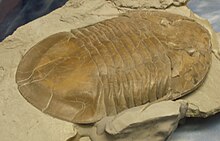Isotelus
| Isotelus Temporal range:
| |
|---|---|

| |
| Isotelus brachycephalus | |
| Scientific classification | |
| Domain: | Eukaryota |
| Kingdom: | Animalia |
| Phylum: | Arthropoda |
| Class: | †Trilobita |
| Order: | †Asaphida |
| Family: | †Asaphidae |
| Genus: | †Isotelus Dekay, 1824 |
| Species | |
|
See text | |
Isotelus is a genus of asaphid trilobites from the middle and upper Ordovician period, fairly common in the Northeastern United States, northwest Manitoba, southwestern Quebec and southeastern Ontario. One species, Isotelus rex, is currently the world's largest trilobite ever found as a complete fossil, and was probably exceeded in size only by Hungioides bohemicus, in which the specimens probably exceeding Isotelus rex in size are only known from partial remains.[1]
Discovery and naming

A specimen of Isotelus rex, from Churchill, Manitoba, is the largest complete trilobite ever found. Discovered by Dave Rudkin (Royal Ontario Museum), Robert Elias (University of Manitoba), Graham Young (Manitoba Museum) and Edward Dobrzanske (Manitoba Museum) in 1999, it measures 720 millimetres (28 in) in length, 400 millimetres (16 in) in maximum width (across the cephalon) and 70 millimetres (3 in) in maximum height (at the posterior midpoint of the cephalon).[2][3][4]
A number of species have been described:
- I. aktchokensis Weber, 1948
- I. bradleyi Amati, 2014
- I. copenhagenensis Ross, Jr. & Shaw 1972
- I. frognoensis Owen, 1981
- I. gigas Dekay, 1824
- I. harrisi Raymond, 1905 (synonym I. platymarginatus Raymond, 1910)
- I. iowensis Owen, 1852
- I. kimmswickensis Bradley, 1930
- I. maximus Locke, 1838
- I. megistos Locke, 1842
- I. parvirugosus Chatterton & Ludvigsen, 1976
- I. skapaneidos Amati, 2014
- I. susae Whitfield, 1882
- I. violaensis Amati, 2014
- I. walcotti Walcott, 1918 (synonym I. planus De Mott, 1963)
Many specimens have also been found in Ohio, where Isotelus maximus is the state fossil.[5]
References
- ^ Gutiérrez-Marco, Juan C.; Sá, Artur A.; García-Bellido, Diego C.; Rábano, Isabel; Valério, Manuel (2009). "Giant trilobites and trilobite clusters from the Ordovician of Portugal". Geology. 37 (5): 443–446. Bibcode:2009Geo....37..443G. doi:10.1130/g25513a.1. ISSN 1943-2682.
- ^ Rudkin, D.A.; Young, G.A.; Elias, R.J.; Dobrzanske, E.P. (2003). "The World's biggest Trilobite: Isotelus rex new species from the Upper Ordovician of northern Manitoba, Canada". Journal of Paleontology. 70 (1): 99–112. doi:10.1666/0022-3360(2003)077<0099:TWBTIR>2.0.CO;2. ISSN 0022-3360.
- ^ S. M. Gon III (2005-08-17). "The World's Largest Trilobites".
- ^ P. Z. Myers (2005-04-25). "Isotelus rex, biggest trilobite ever". Archived from the original on 2007-11-12.
- ^ "Ohio's State Fossil - Isotelus".
